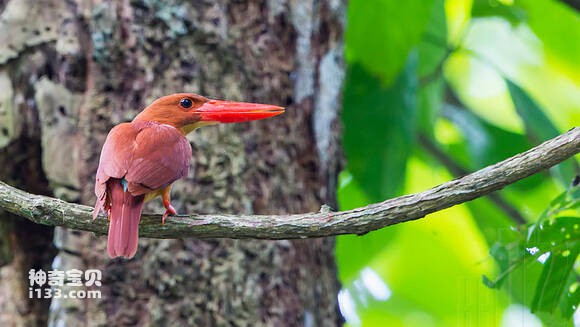Halcyon coromanda
IUCN
LCBasic Information
Scientific classification
- name:Halcyon coromanda
- Scientific Name:Halcyon coromanda,Ruddy Kingfisher
- Outline:Climbing birds
- Family:
Vital signs
- length:26.8-27.4cm
- Weight:98-107g
- lifetime:No textual research information is available
Feature
Distribution and Habitat
Jadeite is the northernmost member of the subfamily, although its main distribution area is in Southeast Asia, but the northernmost distribution across Japan to Sakhalin Island, in China can be seen in the Changbai Mountain area.
Country of origin: Bhutan, Brunei Darussalam, China, India, Indonesia, Japan, Korea, Lao People's Democratic Republic, South Korea, Lao People's Democratic Republic, Malaysia, Myanmar, Nepal, Philippines, Singapore, Thailand, Vietnam.
Possible extinction: Bangladesh; Travellers: Cambodia, Russian Federation.
The red jade mainly lives in the low mountains and the foot of the plain broad-leaved forest and mixed forest along the river. It occupies quite a wide range of habitats. In the Himalayas, Northeast China and Japan, the main habitat is mountainous, at high elevations standing on the edge of running rivers, in dense forests of evergreen trees up to 1800 m above sea level. In the tropics, life is found in forested coastlines, coconut grove
Appearance
Red jade head, neck, back, waist and tail cover feathers, tail feathers brown red, waist center and tail cover feather base central green blue. The wings are brown and red, like the back. Chin and throat white; A thick yellowish-white stripe extending from under the mouth to both sides of the back neck; The foreneck, thorax, abdomen and undertail coverts are reddish yellow, the foreneck and thorax are deep, and the abdomen is shallow. Iris brown; Mouth bright red, tip bright light white; The tarsus and toe are bright yellow.
Size measurement: weight 98-107 grams, ♀104 grams; The body length is 268-274 mm, ♀274 mm; Mouth peak 53.5-61 mm, ♀59.5 mm; Wings are 121-124 mm, ♀125.5 mm; Tail 73-81 mm, ♀83 mm; The tarsus is 20-22 mm, ♀22 mm. (Note: ♂ males; ♀ female)
Details
Halcyon coromanda, Ruddy Kingfisher, has 10 subspecies.

The red jade is solitary or bisexual, lonely, generally resting on the stumps and rocks of the river, and sometimes on the low branches of small trees near the river. Often for a long time motionless staring at the water, as soon as the fish and shrimp in the water, immediately with a very rapid and fierce posture into the water with the mouth to catch. Sometimes the wings are suspended in the air, looking down at the water, and the food immediately plunges into the water and is quickly captured. A fast, rounded two-syllable or three-syllable call that is very loud for territorial disputes and slows down. Live in the same place for at least 6 years. Hunt for bass in and around the same pond. Like other kingfishers, they flap their wings to kill fish in trees and then eat them. Completely carnivorous. The inland subspecies mainly feed on insects (beetles, locusts, grasshoppers, larvae), other small arthropods, small snails, and lizards. Not only is it a freshwater prey, but in coastal areas, the red jade also eats crayfish, fish, frogs, tadpoles, and crabs.
The breeding season is from May to July. Nests are made in holes in the ground or on banks, or in trees more than 3 meters above the ground that are hollowed out in forests. There are also subspecies that nest in termite mounds. Usually nests on the ground are covered with vegetation. The entrance to the nest is 5 cm and 45 to 100 cm deep. Females usually lay four to six eggs, which are 26-29 mm x 22-24 mm in size, with an average of 27 x 23 mm. Parents take turns incubating the eggs and caring for the chicks, which become nocturnal.

Listed on the International Union for Conservation of Nature (IUCN) 2013 Red List of Threatened Species ver 3.1 - Not Threatened (LC).

Protect wild animals and eliminate wild meat.
Maintaining ecological balance is everyone's responsibility!








